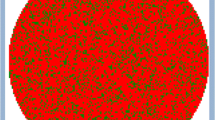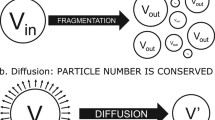Abstract
The development of a computational tool to design bioerodible devices with optimal release characteristics is presented. This computational tool uses cellular automata and discrete iterations to model and simulate the release of bioactive agents (drugs) from bioerodible matrices. The simulations can accurately model surface erosion processes in multicomponent systems of arbitrary geometry and with different dissolution rates for each component. Simulation results are analyzed to show how the overall release rates are affected by the intrinsic dissolution rates, drug loading and the dispersion of the drug in the bioerodible matrix. Heterogeneities in the structure of the bioerodible matrix that can lead to local variations of erosion rates are also considered. A strongly nonlinear dependence of release rates on drug loading and dispersion is obtained and the effects of matrix heterogeneities are elucidated. Finally, guidelines are presented for screening of alternatives to minimize the development effort and experimentation required for designing devices with desired release characteristics.
Similar content being viewed by others
References
H. Brem, M.S. Mahaley, N.A. Vick, K.L. Black, S.C. Schold, P.C. Burger, A.H. Friedman, I.S. Ciric, T.W. Eller, J.W. Cozzens and J.N. Kenally, J. Neurosurg. 74, 441 (1991).
J.W. Leenslag, A.J. Pennings, R. M. Ruud, F. R. Rozema and G. Boering, Biomaterials, 8, 70 (1987).
C. Li, and J. Kohn, Macromolecules, 22, 2029 (1989).
R. Langer, Chem. Eng. Commun. 6, 1 (1980).
H.B. Rosen, J. Kohn, K. Leong and R. Langer, in Controlled Release Systems: Fabrication Technology, edited by D.S.T. Hsieh (CRC Press, Boca Raton, FL, 1988) p. 83.
K. Zygourakis, Polymer Prepr. (Amer. Chem. Soc., Div. Polym. Chem.) 30, 456 (1989).
K. Zygourakis, Chem. Eng. Sci. 45, 2359 (1990).
A. Göpferich and R. Langer, Macromolecules, 26, 4105 (1993).
D.O. Cooney, AIChE J. 18, 446 (1972).
Author information
Authors and Affiliations
Rights and permissions
About this article
Cite this article
Zygourakis, K. Design of Bioerodible Devices with Optimal Release Characteristics. MRS Online Proceedings Library 331, 79–84 (1993). https://doi.org/10.1557/PROC-331-79
Published:
Issue Date:
DOI: https://doi.org/10.1557/PROC-331-79




